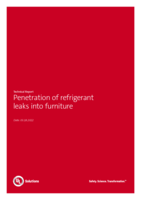
Penetration of Refrigerant Leaks into Furniture
Current North American and international safety standards contain requirements that may limit the amount of refrigerant that can be used in a space based on the installed room.

Previous research on refrigerant releases investigated the refrigerant concentration in the room space. This research took into account the effect that obstructions could have on the dispersal of refrigerant in the room space. These projects identified that obstructions could limit the refrigerant’s ability to mix in the room space.
Researchers disagree on the significance of furniture volume in a space when determining the safe charge quantity of flammable refrigerants. Some stakeholders claim that furniture occupies a significant volume, thereby increasing the refrigerant concentration by reducing the room volume available to dilute the refrigerant. Proponents of this model advocate reducing the refrigerant charge to account for the volume of the furniture. Others maintain that because refrigerant gasses—which have virtually no surface tension—flow into small gaps, furniture volume does little to prevent penetration. Most researchers agree that soft furnishings, such as cushions for chairs and sofas, allow refrigerants to penetrate.
This paper identifies furniture and structures with hollow interiors have little impact on room volume calculations.

Penetration of Refrigerant Leaks into Furniture
Have questions, need specifics? Let's get this conversation started.